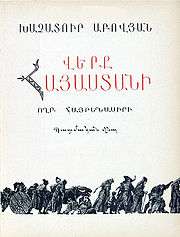Wounds of Armenia
|
Cover of the 1959 edition | |
| Author | Khachatur Abovian |
|---|---|
| Language | Eastern Armenian |
| Genre | Historical novel[1][2][3] |
Publication date | 1858 |
Wounds of Armenia (Armenian: Վերք Հայաստանի Verk Hayastani) is an 1841 historical novel by Khachatur Abovian. Written in the Araratian (Yerevan) dialect,[4] Wounds of Armenia is considered Abovian's chef d'œuvre.[2][5] It is Abovian's debut novel, the first Armenian novel[6] and the first modern Eastern Armenian literary work.[7][8] Thanks to Wounds of Armenia, Khachatur Abovian is acknowledged as the founder of the modern Eastern Armenian language.[2][5]
It was first published in 1858 in Tiflis, which was the cultural center of Russian Armenians before the Russian Civil War,[9] ten years after Abovian disappeared.[8]
Name
The book is commonly known as Wounds of Armenia (Verk Hayastani),[4][6][7] although it was originally titled Wounds of Armenia: Lamentation of a Patriot (Վերք Հայաստանի. ողբ հայրենասերի) by Abovian.[10][11]
Background
Khachatur Abovian was born in Kanaker, a small village near Yerevan in 1809 which was part of the Persian Empire at the time. In 1827, Yerevan was captured by the Russians. From 1830 to 1836, Abovian studied at the University of Dorpat.[12] Abovian wrote the book in 1841.[4][6][7][8][13]
Plot

The story which Abovian named Wounds of Armenia is based on an incident which happened in his hometown Kanaker during the Russo-Persian War of 1826–1828.
A young Armenian girl named Takhuni is kidnapped by soldiers of Hossein Khan Sardar, the head of the Persian political entity around Yerevan. Aghasi, who is the main hero, kills the Sardar's men and saves her. The Persian governor's brother Hassan decides to punish Aghasi and thus destroys a number of Armenian towns.[3][6]
The 2005 book The Heritage of Armenian Literature by Agop Jack Hacikyan et al argues that "though symbolic, the incident, was sufficiently potent to arouse sentiments of patriotism, national pride, and dignity". The authors then note that "the book, reads like a poem, in which the author, like a son, is having an honest, forthright talk with the people, in their own Kanaker dialect". They claim "its message is direct and strong: an appeal from the bottom of the heart".[6]
Publications and translations
The novel was first published in 1858 in Tiflis, then part of the Russian Empire, now called Tbilisi as the capital of Georgia.[1][2] It was later published during the Soviet era (1948, 1959, 1975) and in independent Armenia (2005, 2009). Since now the novel had 16 publications in Armenian in separate books.
The first language to be translated into was Russian (by Sergey Shervinsky). In 1948, the Russian translated edition was published in both in Yerevan and Moscow and later republished in 1955, 1971 and 1977 in Yerevan.[14] In 1978 and 2005 it was published in Moscow.
In 2005, Vahé Baladouni translated the preface of Abovian's novel into English. It was published in Yerevan by the Museum of Literature and Art. (ISBN 9993060607, OCLC 76872486)
The novel was also published in Lithuanian (1980) and Romanian (2015).
See also
References
- 1 2 Dum-Tragut, Jasmine (2009). Armenian: Modern Eastern Armenian. Amsterdam: John Benjamins Publishing. p. 3. ISBN 9789027238146.
- 1 2 3 4 Baladouni, Vahé; Gery, John (2010). Hmayeak Shēms: A Poet of Pure Spirit. Lanham, Maryland: University Press of America. p. 91. ISBN 9780761850540.
- 1 2 Kurkjian, Vahan M. (2008). A History of Armenia. Los Angeles: Indo-European Publishing. p. 338. ISBN 9781604440126.
- 1 2 3 Panossian, Razmik (2006). The Armenians from kings and priests to merchants and commissars. London: Columbia University Press. p. 143. ISBN 9780231511339.
- 1 2 Bardakjian, Kevork B. (2000). Wayne State University Press. Detroit: Wayne State Univ. Press. p. 135. ISBN 9780814327470.
- 1 2 3 4 5 Hacikyan, Agop Jack; Basmajian, Gabriel; Franchuk, Edward S.; Ouzounian, Nourhan (2005). The Heritage of Armenian Literature: From the eighteenth century to modern times. Detroit: Wayne State University Press. p. 213. ISBN 9780814332214.
- 1 2 3 Nichanian, Marc (2002). Writers of Disaster: Arm. Literature in the Twentieth Century. Princeton, NJ: Gomidas Inst. p. 87. ISBN 9781903656099.
- 1 2 3 Kazanjian, David (2003). Loss: The Politics of Mourning. Los Angeles: University of California Press. p. 144. ISBN 9780520232365.
- ↑ Petrosian, Irina; Underwood, David (2006). Armenian Food: Fact, Fiction & Folklore. Bloomington, Indiana: Yerkir Publ. p. 8. ISBN 9781411698659.
Money, jobs, and success were attainable in Tiflis, which became virtually the center of Eastern Armenian life. At the beginning of the 20th century, Tiflis had a population of 350,000, while Yerevan had only 35,000.
- ↑ Baladouni (2005) p. 4
- ↑ Hacikyan (2005) p. 89 "Khachatur Abovian (1809-48) is regarded as one of the founders of Eastern Armenian ashkharhabar, with his milestone work Verk Hayas- tani kam Voghb hayrenasiri (Wounds of Armenia, or lamentation of the patriot)."
- ↑ Khachaturian, Lisa. Cultivating Nationhood in Imperial Russia: The Periodical Press and the Formation of a Modern Armenian Identity. Transaction Publishers. p. 52. ISBN 1-4128-0848-0.
- ↑ Hovanesian, Zareh (2000). The philatelic History of Armenia. Z. Hovanesian. p. 146. ISBN 9780615119984.
- ↑ Акопян, П. О. Хачатур Абовян и его "Раны Армении" (in Russian). ArmenianHouse.org. Retrieved 22 March 2013.

